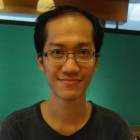Bill Hsuing

Title: IB PhD Student, Biomimicry Fellow
Dept/Program: Biology
Email: borkaihsiung@gmail.com
Website: http://germinature.com/
Biography
My first graduate school study was in Taiwan. I studied in the Institute of Molecular&Cellular Biology, NTHU. There I got very solid training in molecular and cellular biology, lab experience and experimental techniques. Although doing scientific research is interesting, somehow I wish the research that I did could be more applicable to real life situations, help to change the world and make it a better place. So I went to UCR to study in Biomedical Sciences. While I was in UCR, I did research related to neurodegeneration and neuroinflammation diseases because of my grandmother, who was a patient suffering from early onset Alzheimer's disease for more than a decade. After graduating with a second master’s degree from UCR, I worked at La Jolla Bioengineering Institute in La Jolla, Calif. for a year doing research related to cardiovascular diseases. After that, I went back to Taiwan to work in an innovation team in a chemical company.
Now an emerging field called “biomimicry” brings me to The University of Akron. With biomimicry in mind, I’m particularly interested in the potential material applications of spider silks. Therefore, I’m currently doing spider research in Dr. Todd Blackledge’s lab. For me, biomimicry is the hope to sustainable and more eco-friendly technologies. It may as well create a paradigm shift and totally revolutionized the way we make things and how we see industrialization since the age of industrial revolution. However, in the field of biomimicry now, there are still some fundamental gaps between biological research ends and the application ends in the real world. Hopefully, with what I will learn in the Integrated Bioscience PhD program and the support from Biomimicry Fellowship, I will be enabled to bridge these gaps. In the end, let’s hope biomimicry becomes a fundamental core concept that is rooted in everyone’s mind, so everyone can use it in all aspects of daily life.
Publications
Melchior, B., Garcia, A., Hsiung, B.-K., Lo, K., Doose, J., Thrash, J., Stalder, A., Staufenbiel, M., Neumann, H. and Carson, MJ., Dual Induction of TREM2 and Tolerance related transcript, Tmem176b in amyloid transgenic mice: implications for vaccine-based therapies for Alzheimer’s disease. - ASN neuro 2010;2(3): p. 157-70.
Lin, S.-C., Liu, W.-T., Liu, S.-H., Chou, W.-I., Hsiung, B.-K., Lin, I.-P., Sheu, C.-C. and Chang M D.-T., Role of the linker region in the expression of Rhizopus oryzae glucoamylase. BMC Biochem, 2007. 8: p. 9.
Chou, W.-I., Pai, T.-W., Liu, S.-H., Hsiung, B.-K. and Chang M D.-T., The family 21 carbohydrate-binding module of glucoamylase from Rhizopus oryzae consists of two sites playing distinct roles in ligand binding. Biochem J, 2006. 396(3): p. 469-77.
Education
2000, B.S. Applied Chemistry, National Chiao Tung University, Hsinchu, Taiwan, R.O.C.; 2002, M.S. Molecular&Cellular Biology, National Tsing Hua University, Hsinchu, Taiwan, R.O.C.; 2009, M.S. Biomedical Sciences. University of California, Riverside
